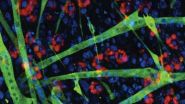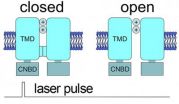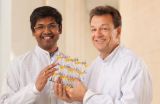(Press-News.org) Dog owners in the Caucasus Mountains of Georgia might want to consider penning up their dogs more often: hybridization of wolves with shepherd dogs might be more common, and more recent, than previously thought, according to a recently published study in the Journal of Heredity (DOI: 10.1093/jhered/esu014).
Dr. Natia Kopaliani, Dr. David Tarkhnishvili, and colleagues from the Institute of Ecology at Ilia State University in Georgia and from the Tbilisi Zoo in Georgia used a range of genetic techniques to extract and examine DNA taken from wolf and dog fur samples as well as wolf scat and blood samples. They found recent hybrid ancestry in about ten percent of the dogs and wolves sampled. About two to three percent of the sampled wolves and dogs were identified as first-generation hybrids. This included hybridization between wolves and the shepherd dogs used to guard sheep from wolf attacks.
The study was undertaken as part of Dr. Kopaliani's work exploring human-wolf conflict in Georgia. "Since the 2000s, the frequency of wolf depredation on cattle has increased in Georgia, and there were several reports of attacks on humans. Wolves were sighted even in densely populated areas," she explained.
"Reports suggested that, unlike wild wolves, wolf-dog hybrids might lack fear of humans, so we wanted to examine the ancestry of wolves near human settlements to determine if they could be of hybrid origin with free-ranging dogs such as shepherds," she added.
The research team examined maternally-inherited DNA (mitochondrial DNA) and microsatellite markers to study hybridization rates. Microsatellite markers mutate easily, as they do not have any discernible purpose in the genome, and are highly variable even within a single population. For these reasons, they are often used to study hybridization.
"We expected to identify some individuals with hybrid ancestry, but it was quite surprising that recent hybrid ancestry was found in every tenth wolf and every tenth shepherd dog," said study co-author Tarkhnishvili.
"Two dogs out of the 60 or so we studied were inferred to be first generation hybrids," he added.
The study also found that about a third of the dogs sampled shared relatively recent maternal ancestry with local wolves, not with wolves domesticated in the Far East, where most experts believe dogs were first domesticated.
The research team used several alternate methods to confirm their results, and came to the same conclusions with each approach.
The shepherd dogs studied are a local breed used to guard livestock. "Ironically, their sole function is to protect sheep from wolves or thieves," Kopaliani explained. "The shepherd dogs are free-ranging, largely outside the tight control of their human masters. They guard the herds from wolves, which are common in the areas where they are used, but it appears that they are also consorting with the enemy."
INFORMATION: END
Wolves at the door: Study finds recent wolf-dog hybridization in Caucasus region
2014-04-14
ELSE PRESS RELEASES FROM THIS DATE:
Regenerating muscle in Duchenne muscular dystrophy: Age matters
2014-04-14
LA JOLLA, Calif., April 11, 2014 — A team of scientists led by Pier Lorenzo Puri, M.D., associate professor at Sanford-Burnham Medical Research Institute (Sanford-Burnham), in collaboration with Fondazione Santa Lucia in Rome, Italy, have published details of how a class of drugs called "HDACis" drive muscle-cell regeneration in the early stages of dystrophic muscles, but fail to work in late stages. The findings are key to furthering clinical development of HDACis for Duchenne muscular dystrophy (DMD), an incurable muscle-wasting disease.
A symphony to rebuild muscle
The ...
New 'tunable' semiconductors will allow better detectors, solar cells
2014-04-14
One of the great problems in physics is the detection of electromagnetic radiation – that is, light – which lies outside the small range of wavelengths that the human eye can see. Think X-rays, for example, or radio waves.
Now, researchers have discovered a way to use existing semiconductors to detect a far wider range of light than is now possible, well into the infrared range. The team hopes to use the technology in detectors, obviously, but also in improved solar cells that could absorb infrared light as well as the sun's visible rays.
"This technology will also ...
A stable model for an unstable target
2014-04-14
A study in The Journal of General Physiology provides new insights about singlet oxygen and sets the stage for better understanding of this highly reactive and challenging substance.
Singlet oxygen is an electronically excited state of oxygen that is less stable than normal oxygen. Its high reactivity has enabled its use in photodynamic therapy, in which light is used in combination with a photosensitizing drug to generate large amounts of singlet oxygen to kill cancer cells or various pathogens.
Light-generated singlet oxygen also plays a role in a range of biological ...
Better solar cells, better LED light and vast optical possibilities
2014-04-14
Changes at the atom level in nanowires offer vast possibilities for improvement of solar cells and LED light. NTNU-researchers have discovered that by tuning a small strain on single nanowires they can become more effective in LEDs and solar cells.
NTNU researchers Dheeraj Dasa and Helge Weman have, in cooperation with IBM, discovered that gallium arsenide can be tuned with a small strain to function efficiently as a single light-emitting diode or a photodetector. This is facilitated by the special hexagonal crystal structure, referred to as wurtzite, which the NTNU ...
Pioneering findings on the dual role of carbon dioxide in photosynthesis
2014-04-14
Scientists at Umeå University in Sweden have found that carbon dioxide, in its ionic form bicarbonate, has a regulating function in the splitting of water in photosynthesis. This means that carbon dioxide has an additional role to being reduced to sugar. The pioneering work is published in the latest issue of the scientific journal PNAS.
It is well known that inorganic carbon in the form of carbon dioxide, CO2, is reduced in a light driven process known as photosynthesis to organic compounds in the chloroplasts. Less well known is that inorganic carbon also affects the ...
The result of slow degradation
2014-04-14
This news release is available in German. Although persistent environmental pollutants have been and continue to be released worldwide, the Arctic and Antarctic regions are significantly more contaminated than elsewhere. The marine animals living there have some of the highest levels of persistent organic pollutant (POP) contamination of any creatures. The Inuit people of the Arctic, who rely on a diet of fish, seals and whales, have also been shown to have higher POP concentrations than people living in our latitudes.
Today, the production and use of nearly two dozen ...
Nutrient-rich forests absorb more carbon
2014-04-14
The ability of forests to sequester carbon from the atmosphere depends on nutrients available in the forest soils, shows new research from an international team of researchers including the International Institute for Applied Systems Analysis (IIASA).
The study showed that forests growing in fertile soils with ample nutrients are able to sequester about 30% of the carbon that they take up during photosynthesis. In contrast, forests growing in nutrient-poor soils may retain only 6% of that carbon. The rest is returned to the atmosphere as respiration.
"This paper produces ...
Scientists open door to better solar cells, superconductors and hard-drives
2014-04-14
Using DESY's bright research light sources, scientists have opened a new door to better solar cells, novel superconductors and smaller hard-drives. The research reported in the scientific journal Nature Communications this week enhances the understanding of the interface of two materials, where completely new properties can arise. With their work, the team of Prof. Andrivo Rusydi from the National University of Singapore and Prof. Michael Rübhausen from the Hamburg Center for Free-Electron Laser Science (CFEL) have solved a long standing mystery in the physics of condensed ...
Combs of light accelerate communication
2014-04-14
This news release is available in German.
Miniaturized optical frequency comb sources allow for transmission of data streams of several terabits per second over hundreds of kilometers – this has now been demonstrated by researchers of Karlsruhe Institute of Technology (KIT) and the Swiss École Polytechnique Fédérale de Lausanne (EPFL) in a experiment presented in the journal Nature Photonics. The results may contribute to accelerating data transmission in large computing centers and worldwide communication networks. (DOI: 10.1038/NPHOTON.2014.57.)
The amount of ...
Proteomics International biomarker study closer to a CDx test for diabetic kidney disease
2014-04-14
April 2014, Perth, Australia. Drug discovery company Proteomics International has completed an important milestone towards the development of a companion diagnostic (CDx) test with the validation of several of its protein biomarkers.
The research team authenticated the panel of biomarkers after taking 508 highly curated disease and control samples. Seven biomarkers were validated at high stringency using the company's proprietary mass spectrometry approach.
The mass spectrometry data was then cross-validated using immunoassays in collaboration with the KTH Royal Institute ...




